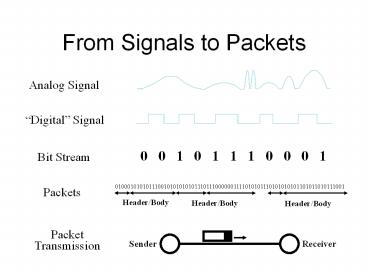From Signals to Packets PowerPoint PPT Presentation
Title: From Signals to Packets
1
From Signals to Packets
2
Why Do We Care?
- How much bandwidth can I get out of a specific
wire (transmission medium)? - What limits the physical size of the network?
- How can multiple hosts communicate over the same
wire at the same time? - How can I manage bandwidth on a transmission
medium?
3
Signal Sum of Waves
4
Modulation
Amplitude
Frequency
Phase
5
(No Transcript)
6
The Nyquist Limit
- A noiseless channel of width H can at most
transmit a binary signal at a rate 2 x H. - E.g. a 3000 Hz channel can transmit data at a
rate of at most 6000 bits/second - Assumes binary amplitude encoding
7
Capacity of a Noisy Channel
- Cant add infinite symbols - you have to be able
to tell them apart. This is where noise comes
in. - Shannons theorem
- C B x log(1 S/N)
- C maximum capacity (bps)
- B channel bandwidth (Hz)
- S/N signal to noise ratio of the channel
- Often expressed in decibels (db). 10 log(S/N).
- Example
- Local loop bandwidth 3200 Hz
- Typical S/N 1000 (30db)
- What is the upper limit on capacity?
- Modems Teleco internally converts to 56kbit/s
digital signal, which sets a limit on B and the
S/N.
PowerShow.com is a leading presentation sharing website. It has millions of presentations already uploaded and available with 1,000s more being uploaded by its users every day. Whatever your area of interest, here you’ll be able to find and view presentations you’ll love and possibly download. And, best of all, it is completely free and easy to use.
You might even have a presentation you’d like to share with others. If so, just upload it to PowerShow.com. We’ll convert it to an HTML5 slideshow that includes all the media types you’ve already added: audio, video, music, pictures, animations and transition effects. Then you can share it with your target audience as well as PowerShow.com’s millions of monthly visitors. And, again, it’s all free.
About the Developers
PowerShow.com is brought to you by CrystalGraphics, the award-winning developer and market-leading publisher of rich-media enhancement products for presentations. Our product offerings include millions of PowerPoint templates, diagrams, animated 3D characters and more.

